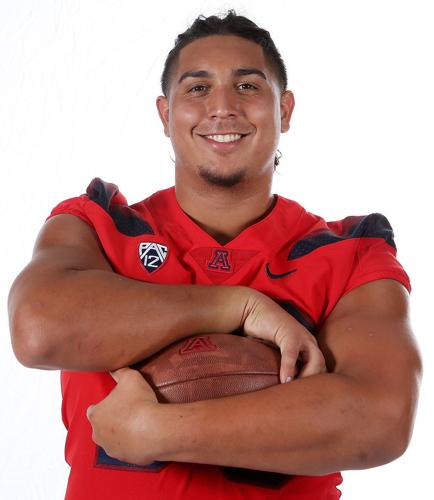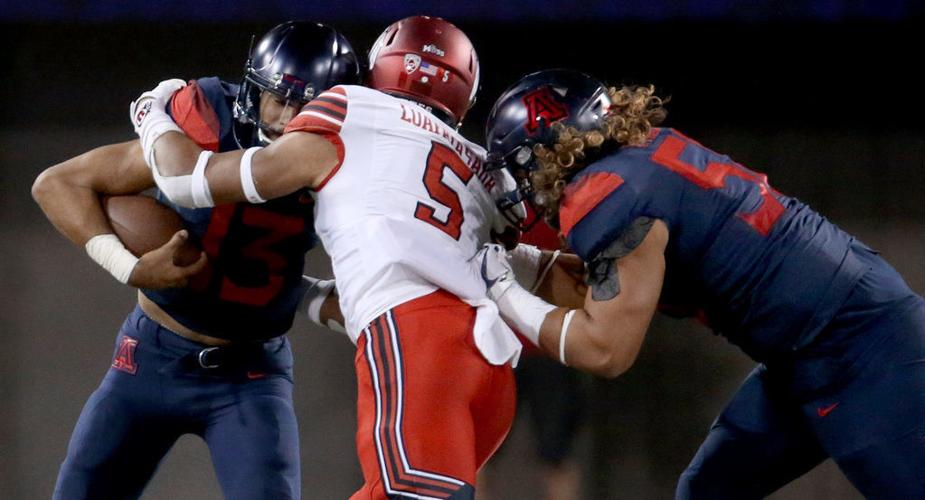The Arizona Wildcats will not have the services of starting left tackle Layth Friekh for the first two games of 2018. That includes a Week 2 visit to Houston, whose defensive line features Ed Oliver, the possible No. 1 overall pick in the 2019 NFL draft.
Friekh isn’t injured. He didn’t do anything wrong.
But in order to gain a fifth year of eligibility, Friekh had to make an appeal to the NCAA, which cut him a deal: Since Friekh appeared in one game in 2014, the cost in ’18 would be two games.
Since the NCAA could have determined that Friekh couldn’t come back at all, everyone was more or less pleased with the outcome.
“I’m not totally happy about the two-game suspension, but I’m nonetheless happy to be here another year,” Friekh said at the time. “It’s worth it to me to come back, better myself and be part of this team one more year.”
If a rule change that coaches unanimously support had been in place, Friekh wouldn’t have had to file an appeal. Nor would he have to sit out the first two games of next season.
The proposal could pass next month. It likely would be too late to help Friekh. But it could help players — and teams — for years to come.
The proposal would allow players to participate in up to four games in a season without losing their redshirt year. Currently, participating in one game — as Friekh briefly did in a blowout win at Utah in late November of his freshman year — means losing an entire year of eligibility.
The only standard exception is if a player suffers a season-ending injury while competing in no more than 30 percent of his team’s games. Even then, the injury has to have occurred in the first half of the season.
The new proposal — which the NCAA will revisit in June after tabling it in April — would eliminate the medical hardship waiver. It would simplify the process: Whether you’re healthy or hurt, if you play in four or fewer games, you don’t lose a year. And it would benefit players, coaches and the sport as a whole, according to its biggest advocate.
‘Health and safety’
Todd Berry, executive director of the American Football Coaches Association, has sought a change to the redshirt rule for almost two decades.
When he was the coach at Illinois State in the late 1990s, Berry ran out of healthy defensive linemen for a playoff game. He asked a freshman who had been redshirting to step in. Berry didn’t want to do it, but he felt he had no choice. Even though it would cost a year of eligibility, the player agreed to play.
“I thought that was unfair for me, and him, to be put in that situation,” Berry said in a phone interview this week.
A few years later, when he was coaching at Army, Berry presented the idea. He’s been fighting for it ever since and hopes the mid-June meetings in Indianapolis will be the finish line.
Why is this cause so important to Berry and the coaches he represents? These are the main arguments:
It would make the game safer. The new redshirt rule would make it easier for coaches and teams to deal with injuries, especially when they decimate a particular position.
If he could tap a scholarship freshman for a game or two, a coach wouldn’t have to consider a walk-on who might not be physically capable of competing at the college level. Additionally, an injured player might be less inclined to rush back if he knew his spot was in capable hands. In either scenario, the team would have better depth.
“Our rationale is health and safety,” Berry said. “I can’t think of a better rationale.”
The sport has changed. When the redshirt rules were first established, Division I teams had 105 scholarship players. The regular season consisted of 11 games. Conference-championship games and the College Football Playoff did not exist.
Now, each FBS team has 85 scholarship players. The regular season is 12 games, more than half of FBS teams participate in a bowl game and the CFP finalists can play in as many as 15 games.
Changes have been made limiting contact in practice and eliminating two-a-days. Allowing greater roster flexibility would further offset the physical demands put on players.
“We play the most physically demanding sport,” said Stanford coach David Shaw, one of five Pac-12 coaches surveyed by the Star about the redshirt rule — all of whom support it.
“It’s happened so many times for us that we’ll get three guys injured and we’ll have to play a freshman, and then those other guys get back healthy. So the guy plays a couple games, and he would normally go back to the bench. But since you’ve already burned his redshirt, you kind of keep him out there to try to utilize that whole freshman year. Instead of saying, ‘Hey, let the guy play a couple games, get his feet wet.’”
It’s a better deal for the players. The vast majority of college players do not go on to play professionally. College represents the last chance to play a sport most of them have played since they were kids.
“They have this limited opportunity to live this dream of playing college football,” Berry said, “and you’re going to rob them of a season?”
Berry cites the case of West Virginia tailback Martell Pettaway. A rash of injuries forced the then-freshman, who was on track to redshirt, to start for the Mountaineers in their 11th game of 2016. He carried 30 times for 181 yards and a touchdown. He played a lesser role in West Virginia’s final two games, totaling 20 rushes.
Pettaway, entering his junior season, has two years of eligibility left. Under the new rule, he’d have three.
“If we’re trying to help kids and not burn redshirts late and those type of things,” Washington coach Chris Petersen said, “it shouldn’t even be limited to four games.”
Petersen was one of three Pac-12 coaches among the five the Star spoke to who called for no game cap at all. Petersen, Cal’s Justin Wilcox and Washington State’s Mike Leach said players simply should have five years of eligibility.
Berry said that isn’t the ultimate objective. The proposal was set at four games to mirror the current cutoff for a medical hardship waiver.
“Coaches are adamant about staying within the scholastic model” of earning a degree in four years, Berry said.
Besides, they don’t want to stray too far from other sports. The notion that football is going rogue is among the reasons a proposal so many favor hasn’t passed yet.
Pros and cons
The redshirt proposal has unanimous support among football coaches “at all levels, which never happens,” Berry said. It would apply to schools at every level above Division III.
If the proposed change is so popular and has so many advantages, why is it still being discussed? Why wasn’t it put into effect years ago?
When it was tabled in April, the NCAA explained the decision as follows:
“Proponents argue that late-season injuries and other factors often require student-athletes who hadn’t played all season to burn a year of eligibility for a small number of games. Others wonder whether the proposal could be applied to other sports, as well, whether the number of games in the proposal is appropriate, and whether the timing of the four games matters.”
Berry and others firmly believe that football belongs in its own category because of the violent nature of the sport and the accompanying injury rate. If the NCAA wanted to use football as a trial balloon for the redshirt rule, Berry would be OK with that.
As for the number of games and timing of player participation, Berry doesn’t believe coaches will try to manipulate the system. He doesn’t envision coaches holding out uber-talented freshmen until late in the season, then springing them on rivals or bowl opponents.
The redshirt rule would be more applicable in a situation like the one Shaw faced when NFL-bound Christian McCaffrey elected to sit out the 2016 Sun Bowl. This is happening with increasing frequency, and it can put a team in a bind if it doesn’t have adequate depth at a particular position.
Opponents of the proposal also expressed concern that teams could suit up midyear enrollees. Berry said that loophole has been closed.
Heading into next month’s NCAA meetings, Berry is cautiously optimistic that the redshirt rule will pass and go into effect in the upcoming season. (It likely wouldn’t be retroactive; sorry, Wildcats fans.) Although he worries that the movement to reform college basketball could take “a lot of oxygen out of the room,” Berry remains hopeful that the powers-that-be will come to their senses.
“To play three snaps in a ballgame and lose the whole year, it’s just not fair. It’s not right,” he said. “We feel like we’re cheating the young people out there, and that’s the wrong place to be.”





